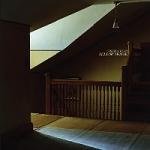
Grizzly Bear Yellow House
(Warp)
Grizzly Bear are not your typical hyper-tense, erratic, New York City scene survivors. More or less a handful of introverted Brooklyn kids, their music sounds like it is bleeding from the wood of a log cabin as opposed to being circulated amongst bright lights and city smog.
Convincingly, the cover of Grizzly Bear's latest album Yellow House hangs with the pensive emptiness of a forgotten attic. Dusty and murky, the air is indeed, yellow. It is also musty with the possession of every moment of the past thirty years.
This mood is no coincidence, as Yellow House was mostly recorded just off Cape Cod, in the home of Edward Droste's mother. And just like the house's poised steps, musty carpets, hidden closets and dusty corners, an estranged mood is inherent in the record, leaving it cocooned and raspy with every staggering intention.
As the follow up to Grizzly Bear's debut Horn of Plenty, Yellow House penetrates further into the conceptual stimulus of a secluded recording environment. Holistically daunting yet benevolent, Horn of Plenty was more or less another 4-track story of articulate murky dissonance recorded by one kid in his bedroom/apartment. This time the story regards Edward Droste, the founding man behind the Grizzly Bear moniker. Despite his frequent dismissal of the debut, its drowning vortex of sweepingly empty, delicate pastures instantly defined the sound of Grizzly Bear.
More innately earthy, Yellow House parades with ethereal might in an often fanciful dimension. As a 12" record pressed to play at 45 rpm, Yellow House at first plays wry and attenuated, as if a tactic for Grizzly Bear to defend their profuse sound. But even as recorded, the opening interlude is spacious and heavy. Sparking to mind a pre-WWII black and white film score, the opening to Easier delicately throws away its melodramatic cape to grab hold of a light folk medley. Ghoulish and graceful, the gentle drums run with hidden stride until they pounce seductively on the first of many structural toss-ups. Banjo, raindrop xylophone and autoharp ring through the piece as it trounces like Hansel and Gretel. This treasure hunt flair, alongside daunting conundrum sound schemes, prove to hem together the album's reoccurring moments of sheer charm. Knife hunts with circular whir and languid plea, its most stringent structure a tight glockenspiel. Central and Remote grabs the album's often hoppy fortitude and takes it into true grace with sodden fragility. Tinged to a crisp with xylophone, it travels to become sonically voluptuous and lush, wading in and out with delicate pertinence. Plans seems to swallow the album with the more cordial of Tom Waits instrumentation, Marla haunting like a disintegrating ghost's opera minuet. On a Neck, On a Spitis perhaps the album's most delicate and fluent piece, toying with freckled folksy jaunts, robust crescendos and verbose crashes of instrumentation.
Compared to the emotionally lethargic lo-fi compliments on Horn of Plenty, the production on Yellow House has stepped up to greet the record's warmth. The back-up vocals seem to fill the record like kindred spirits, and the graven sound effects accentuate the haunting mood. The array of instruments that nestle amongst it leave each flourish and denouement luxuriant, each crescendo bursting with visionary instrumental alliance.
As a full piece band on Yellow House, Edward Droste has transcended the work of his bedroom project with apt and wispy company. It flourishes with the warm psychedelic rays that penetrate its forest canopy; sometimes charged and almost always sentimentally musty. Like a home ripe with the memories of a hundred lives, Yellow House is constantly seeping with new confessions from all of its sun touched walls.
27 October, 2006 - 21:55 — Tara Campbell